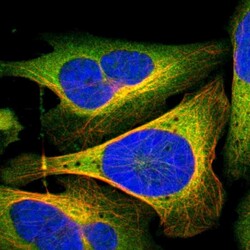Antibody data
- Antibody Data
- Antigen structure
- References [3]
- Comments [0]
- Validations
- Immunocytochemistry [1]
Submit
Validation data
Reference
Comment
Report error
- Product number
- HPA002381 - Provider product page

- Provider
- Atlas Antibodies
- Proper citation
- Atlas Antibodies Cat#HPA002381, RRID:AB_1847244
- Product name
- Anti-DPYSL2
- Antibody type
- Polyclonal
- Description
- Polyclonal Antibody against Human DPYSL2, Gene description: dihydropyrimidinase-like 2, Alternative Gene Names: CRMP2, DHPRP2, DRP-2, DRP2, Validated applications: ICC, IHC, WB, Uniprot ID: Q16555, Storage: Store at +4°C for short term storage. Long time storage is recommended at -20°C.
- Reactivity
- Human, Mouse, Rat
- Host
- Rabbit
- Conjugate
- Unconjugated
- Isotype
- IgG
- Vial size
- 100 µl
- Concentration
- 0.1 mg/ml
- Storage
- Store at +4°C for short term storage. Long time storage is recommended at -20°C.
- Handling
- The antibody solution should be gently mixed before use.
Submitted references Tianeptine Affects the Improvement of Behavioral Defects, such as Schizophrenia, Caused by Maternal Immune Activation in the Mice Offspring.
Pivotal role of DPYSL2A in KLF4-mediated monocytic differentiation of acute myeloid leukemia cells
Effects of Tianeptine on Adult Rats Following Prenatal Stress.
Kwon JT, Jung K
Central nervous system agents in medicinal chemistry 2023 Sep 5;23(3):157-66
Central nervous system agents in medicinal chemistry 2023 Sep 5;23(3):157-66
Pivotal role of DPYSL2A in KLF4-mediated monocytic differentiation of acute myeloid leukemia cells
Noura M, Morita K, Kiyose H, Matsuo H, Nishinaka-Arai Y, Kurokawa M, Kamikubo Y, Adachi S
Scientific Reports 2020;10(1)
Scientific Reports 2020;10(1)
Effects of Tianeptine on Adult Rats Following Prenatal Stress.
Lee H, Kim HK, Kwon JT, Kim YO, Seo J, Lee S, Cho IH, Kim HJ
Clinical psychopharmacology and neuroscience : the official scientific journal of the Korean College of Neuropsychopharmacology 2018 May 31;16(2):197-208
Clinical psychopharmacology and neuroscience : the official scientific journal of the Korean College of Neuropsychopharmacology 2018 May 31;16(2):197-208
No comments: Submit comment
Supportive validation
- Submitted by
- Atlas Antibodies (provider)
- Main image

- Experimental details
- Immunofluorescent staining of human cell line U-2 OS shows localization to plasma membrane & cytosol.
- Sample type
- Human
 Explore
Explore Validate
Validate Learn
Learn Western blot
Western blot Immunocytochemistry
Immunocytochemistry